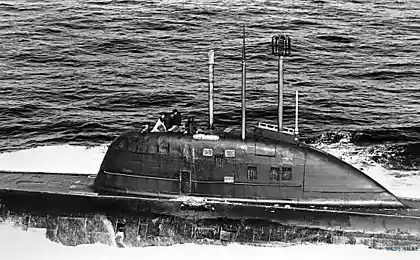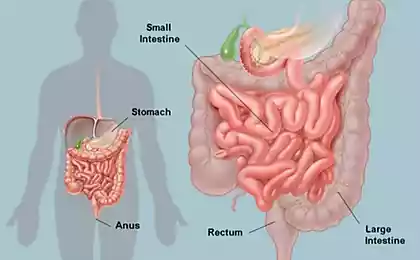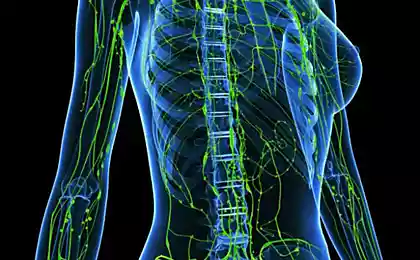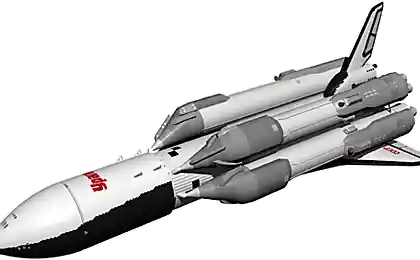779
Multi-purpose aerospace system.
21 photos
Multi-purpose aerospace system (MAX)
Development status. Technological advance
Work on the project underway MAX "NPO Molniya" since the completion of the OK "Buran". In 1988, a large co-operatives (about 70 enterprises of aviation and space industry) developed preliminary design in 220 volumes.
In support of the design specifications a large volume of experimental research in aerodynamics, gas dynamics, strength of structural elements and other areas.
Made full-scale models of the tail of the orbital plane and the external fuel tank. It has been flight-tested the first instance of the base of the AN-225 "Mriya". Practically completed the development of the design documentation in the orbital plane and the fuel tank.
To date, the development of MAX spent about $ 1, 5 billion. In current prices.
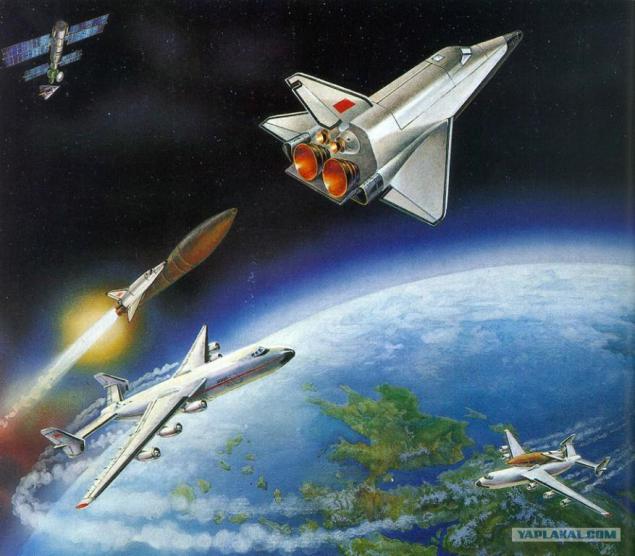
2. After the collapse of the Soviet Union structural and technological layout of the external fuel tank Multipurpose Aerospace System (MAKS) remained in the territory of independent Ukraine, in the shops NGO "Southern." Several years ago, the NGO "Lightning" - the leading developer of MAX - financed the unique transport operation - the delivery of tanks in Russia, on the territory of its subcontractor - Experimental Machine-Building Plant named after V. Myasishev. On the complexity and all the twists and turns of this operation, we will tell, but for now the important thing: the tank began to interfere with commercial activity EMZ, taking place in an open area in the suburban area LII Zhukovsky, where cars were stored not cleared. In this situation, the former management EMZ (former General Designer Valery Novikov) first exposed NGO "Lightning" account for the commercial (!) Rent of occupied parking lot (!), And when the "Lightning" refused to pay, could "convince" the military customer in the wrong layout tank. After the "resolution" tank military representative was immediately cut, and 12 tons of pure aluminum (layout was heavier than the regular tank by virtue of their technological features) were sold out instantly.
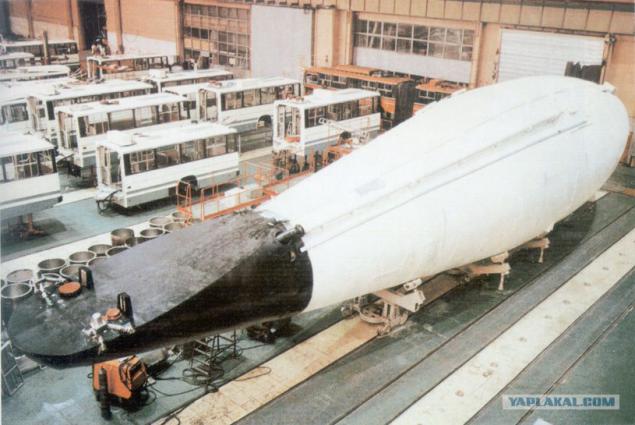
3. Photo technological layout aft fuselage manned orbital plane (option OS-P 1994) Multi-purpose aerospace system in the audience static tests NGO "Lightning." Good layout is visible tail of the plane with vertical fins (fin), fairing rotating mechanism movable wing panels and block the main engines of the RD-701.

4. The unique three-way, sustainer engine RD-701 developed by NPO "Energomash" Running the engine occurs in two phases: the first mode is implemented on the components of kerosene-liquid oxygen, liquid hydrogen, and then after the establishment of stocks of kerosene at high altitudes, the step most energetically favorable components fuel, liquid oxygen, liquid hydrogen. So the combination of modes to reach optimum engine performance during the flight. To date, the RD-701 is the only three-engine in the world.
Features (numerator - the work on the first mode, the denominator - the second): the thrust, tf - 204.1 / 80.9, the specific impulse - 415/460 sec.
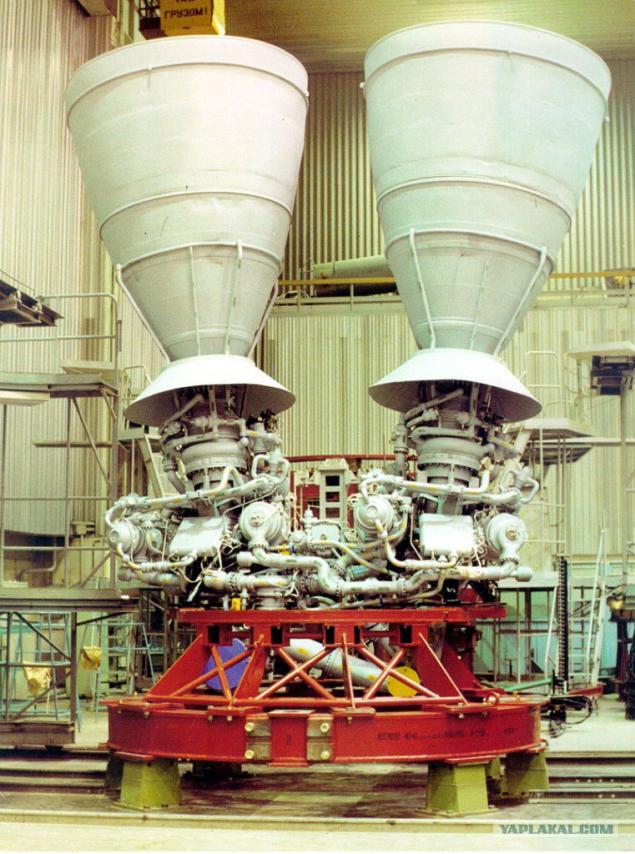
5. Technological layout of the first embodiment of the orbiter MAX in the assembly shop of the NGO "Lightning." Attention is drawn to another arrangement of the propulsion system in the tail section of the fuselage (three oxygen-hydrogen rocket engine NK-45 development NGOs Samara "Trud" honeycombed with a thrust of 90 tons each). It is also the hallmark of this embodiment is a single cabin crew - all subsequent versions were already double.
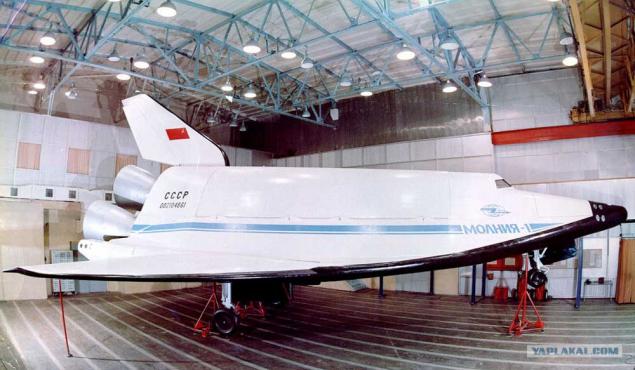
6. One of the important features of MAX is a dynamically-fire separation of the second stage (ligament orbital plane with the external fuel tank) and the first stage (the carrier aircraft An-225 "Mriya") in flight. Conducted much research division mode ensure optimum settings that after patents are exclusive «know-how» NGO "Lightning."

7. AN-225 "Mriya" has been repeatedly tested as a transport platform for air transport orbiter "Buran".
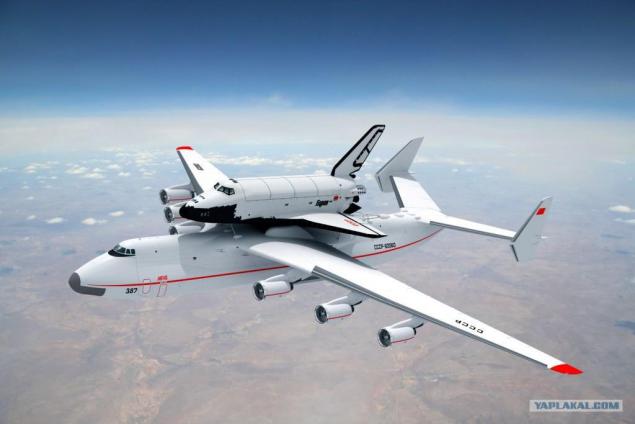
8. At the moment under the Ukrainian flag is used for international commercial transportation.
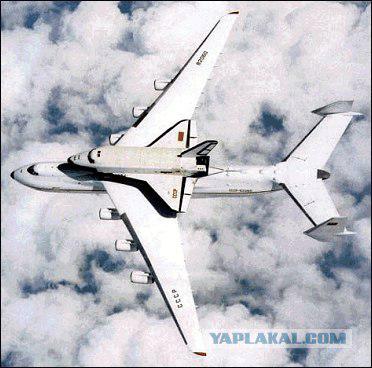
9. Multi-purpose aerospace system "9A-10485" (MAX)
(NGO "Lightning", a variant of the sample 1994)
All images are revealed in an enlarged format
Manned orbital plane
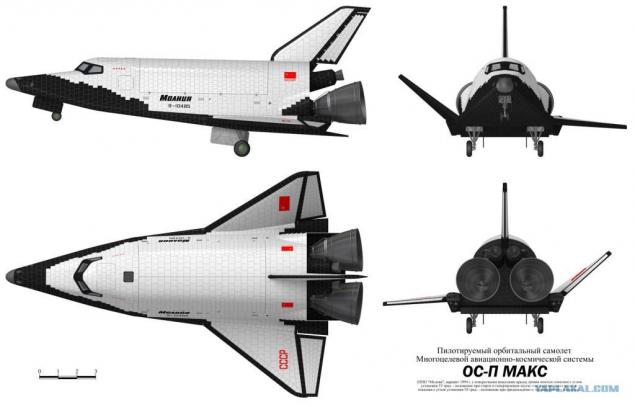
10. The second stage

11. aerospace complex
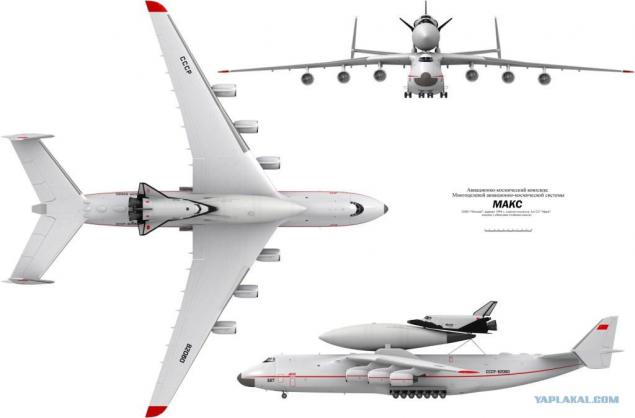
12. Multi-purpose aerospace system
(NGO "Lightning", a variant of the sample in 2001, took part in 2006, with slight modifications in the competition of the Federal Space Agency to establish a manned spacecraft of the new generation under the theme "Clipper», N36 PCF) aerospace complex

13. Basic manned orbital plane OS-II
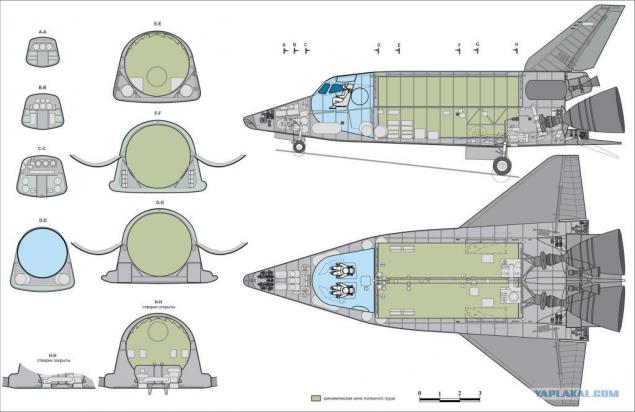
14. The similarity with the "Buran" is obvious, but it is manned orbital plane
"Lightning". 15. The history of the project MAX, as well as general history of aerospace systems in the country, is fraught with still a lot of mysteries. Here is one of them - a single space spy stroke, the scavenging model. 16. The life cycle of MAX
Estimates of the duration of the life cycle of existing launch payloads into orbit allow safe to assume a 30-year period of use of the system.
In accordance with long-term plans of using MAX provides periodic (every 5 years) overhaul elements MAX (planned cost of repairs - up to 15% of production costs) and deep modifications (modernization) of the elements (planned cost versions - up to 30% of costs production) 1 time in 10 years of operation. In carrying out these measures in the event of a commercial need, you can bring the total lifespan MAX up to 50 years.
The proposed production cycle involves the construction of six series of orbital plane, that the pace of launching 30 a year (16 of them - with the upper stage and 14 - manned) and the design life of each aircraft in the 100 flight provides lifetime of MAX without a radical modification of up to 40 years. < br /> 17. It is a variant of the external appearance of the orbital factory, worked in the framework of research "Efficiency».
The basis of the technological complex are four disk-shaped molecular screen, moving perpendicular to the velocity vector. Given that the complex is moving at 400 km in a highly rarefied medium (10-6 mm Hg), the screen is formed stable "shadow" zone of ultra-high vacuum to 10-14 mmHg, in which production facilities are located, producing by molecular beam epitaxy most advanced multi-layer semiconductor nanostructures.
18. Let us recall the famous triad of military targets in space, articulated by General Kamanina back in the mid-1960s: intelligence, intercept and punch. However, Kamanin meant BOC "Spiral", but in fact MAX - "this" spiral "of our day."
A little bit about this project: Air-orbital plane (BOC) "Spiral»
The theme in 1965 to establish a two-stage air-orbital plane (in modern terminology - Aerospace Systems - ACS) received index "Spiral". The Soviet Union is seriously preparing for a large-scale war in space and from space ...
When you get acquainted with the materials of the project "Spiral", unwittingly catch yourself thinking that if you do not pay attention to the yellowed typewritten pages and several outdated terminology before you are not documents of forty years ago, a top-secret design documentation today, and designed to meet at least ten years' development prospects of aerospace systems! Creative designers admire the audacity!
So what is this unique top-secret Soviet project of space weapons?
19. In accordance with the requirements of the customer's designers set about developing a reusable two-stage BOC consisting of hypersonic aircraft overclockers (GSR) and military space plane (OS) from the rocket boosters. Start system provides horizontal, using a booster truck, detachment occurs at the speed of 380-400 km / h. After dialing using the GSR engines required speed and altitude separates the operating system and the further dispersal took place with the help of the two-stage booster rocket engines running on hydrogen, fluorine (F2 + H2) fuel.
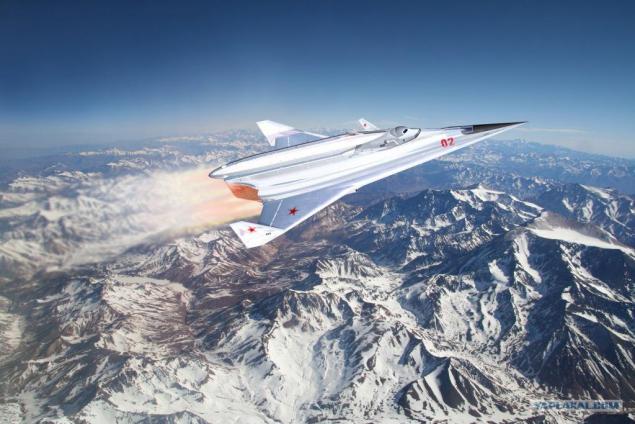
20. Thus, the OKB-155 Mikoyan began in the summer of 1966 for the development of air-space plane, which is due to the peculiarities inherent design solutions and selected the scheme allowed the aircraft start to implement a fundamentally new properties for launch vehicles Military loads into space < br /> - Launch of payload weight is at 9% or more by weight of takeoff;
- Reducing the cost to orbit one kilogram payload 3-3, 5-fold compared with the defense systems in the same propellants;
- Withdrawal of the spacecraft in a wide range of areas and the possibility of rapid retargeting start with the change required by the parallax range airplane;
- Relocation of an independent booster aircraft;
- To minimize the necessary number of airfields;
- Rapid withdrawal of combat orbital plane at any point of the globe;
- Effective maneuvering orbital plane, not only in space but also during descent and landing;
- Samoletnaya landing at night and in adverse weather conditions on a given or chosen crew airfield with any of the three turns.
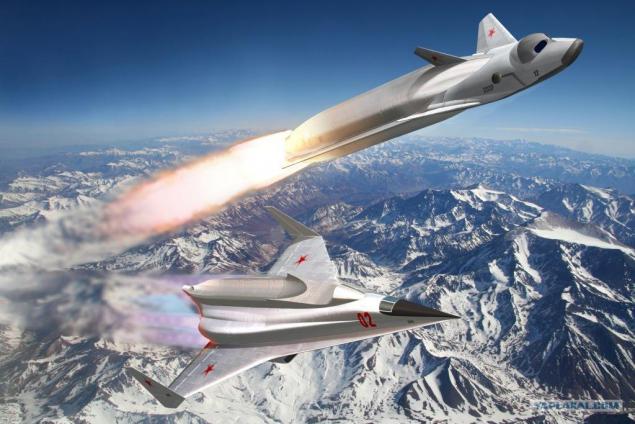
21. At the same time, designers already at the preliminary design stage, seen towards further improvement. The first significant increase in the efficiency of the BOC planned to achieve the development of reusable accelerator ramjet with supersonic combustion, allowing in the future to create completely reusable complex.
Multi-purpose aerospace systems are developed now in many countries, however, according to a number of foreign experts, Russia has moved in this direction on their competitors. Owning such a system is "MAX", would help her in the beginning of the new century to take a firm position in the market of space services.
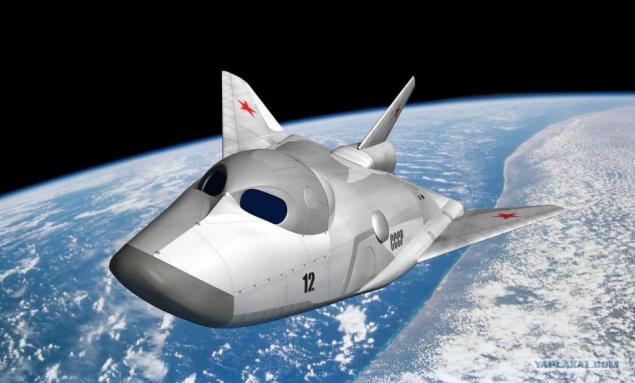
Source:
Multi-purpose aerospace system (MAX)
Development status. Technological advance
Work on the project underway MAX "NPO Molniya" since the completion of the OK "Buran". In 1988, a large co-operatives (about 70 enterprises of aviation and space industry) developed preliminary design in 220 volumes.
In support of the design specifications a large volume of experimental research in aerodynamics, gas dynamics, strength of structural elements and other areas.
Made full-scale models of the tail of the orbital plane and the external fuel tank. It has been flight-tested the first instance of the base of the AN-225 "Mriya". Practically completed the development of the design documentation in the orbital plane and the fuel tank.
To date, the development of MAX spent about $ 1, 5 billion. In current prices.

2. After the collapse of the Soviet Union structural and technological layout of the external fuel tank Multipurpose Aerospace System (MAKS) remained in the territory of independent Ukraine, in the shops NGO "Southern." Several years ago, the NGO "Lightning" - the leading developer of MAX - financed the unique transport operation - the delivery of tanks in Russia, on the territory of its subcontractor - Experimental Machine-Building Plant named after V. Myasishev. On the complexity and all the twists and turns of this operation, we will tell, but for now the important thing: the tank began to interfere with commercial activity EMZ, taking place in an open area in the suburban area LII Zhukovsky, where cars were stored not cleared. In this situation, the former management EMZ (former General Designer Valery Novikov) first exposed NGO "Lightning" account for the commercial (!) Rent of occupied parking lot (!), And when the "Lightning" refused to pay, could "convince" the military customer in the wrong layout tank. After the "resolution" tank military representative was immediately cut, and 12 tons of pure aluminum (layout was heavier than the regular tank by virtue of their technological features) were sold out instantly.

3. Photo technological layout aft fuselage manned orbital plane (option OS-P 1994) Multi-purpose aerospace system in the audience static tests NGO "Lightning." Good layout is visible tail of the plane with vertical fins (fin), fairing rotating mechanism movable wing panels and block the main engines of the RD-701.

4. The unique three-way, sustainer engine RD-701 developed by NPO "Energomash" Running the engine occurs in two phases: the first mode is implemented on the components of kerosene-liquid oxygen, liquid hydrogen, and then after the establishment of stocks of kerosene at high altitudes, the step most energetically favorable components fuel, liquid oxygen, liquid hydrogen. So the combination of modes to reach optimum engine performance during the flight. To date, the RD-701 is the only three-engine in the world.
Features (numerator - the work on the first mode, the denominator - the second): the thrust, tf - 204.1 / 80.9, the specific impulse - 415/460 sec.

5. Technological layout of the first embodiment of the orbiter MAX in the assembly shop of the NGO "Lightning." Attention is drawn to another arrangement of the propulsion system in the tail section of the fuselage (three oxygen-hydrogen rocket engine NK-45 development NGOs Samara "Trud" honeycombed with a thrust of 90 tons each). It is also the hallmark of this embodiment is a single cabin crew - all subsequent versions were already double.

6. One of the important features of MAX is a dynamically-fire separation of the second stage (ligament orbital plane with the external fuel tank) and the first stage (the carrier aircraft An-225 "Mriya") in flight. Conducted much research division mode ensure optimum settings that after patents are exclusive «know-how» NGO "Lightning."

7. AN-225 "Mriya" has been repeatedly tested as a transport platform for air transport orbiter "Buran".

8. At the moment under the Ukrainian flag is used for international commercial transportation.

9. Multi-purpose aerospace system "9A-10485" (MAX)
(NGO "Lightning", a variant of the sample 1994)
All images are revealed in an enlarged format
Manned orbital plane

10. The second stage

11. aerospace complex

12. Multi-purpose aerospace system
(NGO "Lightning", a variant of the sample in 2001, took part in 2006, with slight modifications in the competition of the Federal Space Agency to establish a manned spacecraft of the new generation under the theme "Clipper», N36 PCF) aerospace complex

13. Basic manned orbital plane OS-II

14. The similarity with the "Buran" is obvious, but it is manned orbital plane
"Lightning". 15. The history of the project MAX, as well as general history of aerospace systems in the country, is fraught with still a lot of mysteries. Here is one of them - a single space spy stroke, the scavenging model. 16. The life cycle of MAX
Estimates of the duration of the life cycle of existing launch payloads into orbit allow safe to assume a 30-year period of use of the system.
In accordance with long-term plans of using MAX provides periodic (every 5 years) overhaul elements MAX (planned cost of repairs - up to 15% of production costs) and deep modifications (modernization) of the elements (planned cost versions - up to 30% of costs production) 1 time in 10 years of operation. In carrying out these measures in the event of a commercial need, you can bring the total lifespan MAX up to 50 years.
The proposed production cycle involves the construction of six series of orbital plane, that the pace of launching 30 a year (16 of them - with the upper stage and 14 - manned) and the design life of each aircraft in the 100 flight provides lifetime of MAX without a radical modification of up to 40 years. < br /> 17. It is a variant of the external appearance of the orbital factory, worked in the framework of research "Efficiency».
The basis of the technological complex are four disk-shaped molecular screen, moving perpendicular to the velocity vector. Given that the complex is moving at 400 km in a highly rarefied medium (10-6 mm Hg), the screen is formed stable "shadow" zone of ultra-high vacuum to 10-14 mmHg, in which production facilities are located, producing by molecular beam epitaxy most advanced multi-layer semiconductor nanostructures.
18. Let us recall the famous triad of military targets in space, articulated by General Kamanina back in the mid-1960s: intelligence, intercept and punch. However, Kamanin meant BOC "Spiral", but in fact MAX - "this" spiral "of our day."
A little bit about this project: Air-orbital plane (BOC) "Spiral»
The theme in 1965 to establish a two-stage air-orbital plane (in modern terminology - Aerospace Systems - ACS) received index "Spiral". The Soviet Union is seriously preparing for a large-scale war in space and from space ...
When you get acquainted with the materials of the project "Spiral", unwittingly catch yourself thinking that if you do not pay attention to the yellowed typewritten pages and several outdated terminology before you are not documents of forty years ago, a top-secret design documentation today, and designed to meet at least ten years' development prospects of aerospace systems! Creative designers admire the audacity!
So what is this unique top-secret Soviet project of space weapons?
19. In accordance with the requirements of the customer's designers set about developing a reusable two-stage BOC consisting of hypersonic aircraft overclockers (GSR) and military space plane (OS) from the rocket boosters. Start system provides horizontal, using a booster truck, detachment occurs at the speed of 380-400 km / h. After dialing using the GSR engines required speed and altitude separates the operating system and the further dispersal took place with the help of the two-stage booster rocket engines running on hydrogen, fluorine (F2 + H2) fuel.

20. Thus, the OKB-155 Mikoyan began in the summer of 1966 for the development of air-space plane, which is due to the peculiarities inherent design solutions and selected the scheme allowed the aircraft start to implement a fundamentally new properties for launch vehicles Military loads into space < br /> - Launch of payload weight is at 9% or more by weight of takeoff;
- Reducing the cost to orbit one kilogram payload 3-3, 5-fold compared with the defense systems in the same propellants;
- Withdrawal of the spacecraft in a wide range of areas and the possibility of rapid retargeting start with the change required by the parallax range airplane;
- Relocation of an independent booster aircraft;
- To minimize the necessary number of airfields;
- Rapid withdrawal of combat orbital plane at any point of the globe;
- Effective maneuvering orbital plane, not only in space but also during descent and landing;
- Samoletnaya landing at night and in adverse weather conditions on a given or chosen crew airfield with any of the three turns.

21. At the same time, designers already at the preliminary design stage, seen towards further improvement. The first significant increase in the efficiency of the BOC planned to achieve the development of reusable accelerator ramjet with supersonic combustion, allowing in the future to create completely reusable complex.
Multi-purpose aerospace systems are developed now in many countries, however, according to a number of foreign experts, Russia has moved in this direction on their competitors. Owning such a system is "MAX", would help her in the beginning of the new century to take a firm position in the market of space services.

Source:



